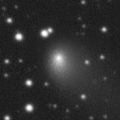
|
Now it is 9.7 mag (Dec. 27, Juan Jose Gonzalez). It brightens up to 8 mag in spring, and it is observable in good condition in the Northern Hemisphere. In the Southern Hemisphere, it is not observable until July.
Date(TT) R.A. (2000) Decl. Delta r Elong. m1 Best Time(A, h)
Jan. 4 3 16.25 55 39.3 1.525 2.270 128 9.3 20:22 (180, 69)
Jan. 11 2 56.43 56 28.1 1.541 2.210 120 9.2 19:35 (180, 68)
|

|
Now it is 11.5 mag (Dec. 27, Juan Jose Gonzalez). It stays bright as 11 mag until January. It stays observable in good condition for a long time in the Northern Hemisphere. In the Southern Hemisphere, it will never be observable again.
Date(TT) R.A. (2000) Decl. Delta r Elong. m1 Best Time(A, h)
Jan. 4 23 29.46 39 52.2 3.023 3.168 89 11.9 18:31 (111, 67)
Jan. 11 23 29.80 40 17.8 3.127 3.180 84 12.0 18:36 (112, 61)
|

|
Now it is 14.5 mag (Dec. 27, Toshihiko Ikemura, Hirohisa Sato).
Date(TT) R.A. (2000) Decl. Delta r Elong. m1 Best Time(A, h)
Jan. 4 0 29.71 12 53.3 5.715 5.784 89 13.5 18:31 ( 32, 65)
Jan. 11 0 32.15 12 59.4 5.827 5.785 82 13.5 18:36 ( 46, 61)
|
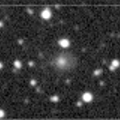
|
Now it is bright as 13.8 mag (Dec. 28, Chris Wyatt). It stays 14 mag until spring. It stays observable for a long time in the Southern Hemisphere. It is not observable until August in the Northern Hemisphere.
Date(TT) R.A. (2000) Decl. Delta r Elong. m1 Best Time(A, h)
Jan. 4 23 8.40 -81 40.4 3.774 3.452 63 14.0 18:31 ( 5,-28)
Jan. 11 23 43.78 -78 48.1 3.781 3.458 63 14.0 18:36 ( 7,-25)
|
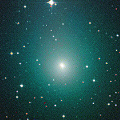
|
It brightened up to 8.3 mag in September (Sept. 20, Maik Meyer). Now it is fading. It has already faded down to 14.9 mag (Dec. 28, Chris Wyatt). In the Southern Hemisphere, it stays observable for a long time after this. In the Northern Hemisphere, it will never be observable again.
Date(TT) R.A. (2000) Decl. Delta r Elong. m1 Best Time(A, h)
Jan. 4 22 4.43 -46 21.8 2.784 2.195 44 14.5 18:31 ( 32, -3)
Jan. 11 22 11.99 -46 41.9 2.902 2.262 41 14.7 18:36 ( 35, -6)
|
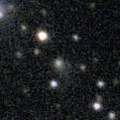
|
Now it is 14.1 mag (Dec. 28, Toshihiko Ikemura, Hirohisa Sato). In the Northern Hemisphere, it is observable at 14 mag in excellent condition in winter. It locates low in the Southern Hemisphere.
Date(TT) R.A. (2000) Decl. Delta r Elong. m1 Best Time(A, h)
Jan. 4 2 49.82 24 55.9 0.805 1.583 124 14.5 19:57 ( 0, 80)
Jan. 11 3 2.46 22 46.3 0.843 1.580 119 14.6 19:42 ( 0, 78)
|

|
New bright comet. Now it is 14.8 mag (Dec. 30, Hidetaka Sato). It approaches to Sun down to 0.84 a.u. in March, then it brightens up to 12 mag. In the Northern Hemisphere, it stays observable for a long time, although it becomes extremely low in March. In the Southern Hemisphere, it is observable only until late January. It seems to be a fragment of C/1988 A1 (Liller), like C/1996 Q1 (Tabur) and C/2015 F3 (SWAN).
Date(TT) R.A. (2000) Decl. Delta r Elong. m1 Best Time(A, h)
Jan. 4 23 39.92 -26 57.2 1.661 1.510 63 14.9 18:31 ( 25, 24)
Jan. 11 23 39.45 -21 44.2 1.662 1.418 58 14.6 18:36 ( 35, 25)
|

|
In the Southern Hemisphere, it is observable at 14.5 mag from winter to spring. In the Northern Hemisphere, it is not observable until August when it fades down to 17 mag.
Date(TT) R.A. (2000) Decl. Delta r Elong. m1 Best Time(A, h)
Jan. 4 18 19.11 -70 16.4 2.598 2.069 47 14.7 5:38 (337,-32)
Jan. 11 19 8.41 -72 25.3 2.531 2.051 50 14.6 5:38 (339,-34)
|
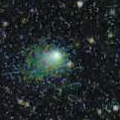
|
Now it is 15.1 mag (Dec. 27, Toshihiko Ikemura, Hirohisa Sato). It will be fading slowly after this.
Date(TT) R.A. (2000) Decl. Delta r Elong. m1 Best Time(A, h)
Jan. 4 22 19.79 -10 38.9 2.355 1.882 50 14.8 18:31 ( 52, 27)
Jan. 11 22 37.53 -9 27.5 2.426 1.905 47 15.0 18:36 ( 56, 26)
|

|
Now it is 14.6 mag (Dec. 28, Chris Wyatt). It will be fading slowly after this. In the Southern Hemisphere, it becomes low from February to March, but it stays observable for a long time. In the Northern Hemisphere, it is not observasble until summer in 2020.
Date(TT) R.A. (2000) Decl. Delta r Elong. m1 Best Time(A, h)
Jan. 4 22 11.11 -58 16.1 3.934 3.380 49 15.1 18:31 ( 24,-11)
Jan. 11 22 20.42 -55 54.0 4.007 3.407 46 15.2 18:36 ( 28,-12)
|
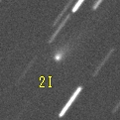
|
Now it is 14.3 mag (Dec. 27, Shigeki Murakami). The orbit is extremely hyperbolic with e=3.35. It is the first interstellar comet in history. It stays 15 mag until January. In the Northern Hemisphere, it will be unobservable in mid January. In the Southern Hemisphere, it is observable in excellent condition.
Date(TT) R.A. (2000) Decl. Delta r Elong. m1 Best Time(A, h)
Jan. 4 12 10.13 -38 12.6 1.943 2.091 84 15.1 5:19 ( 0, 17)
Jan. 11 12 20.06 -42 58.6 1.962 2.140 86 15.3 5:01 ( 0, 12)
|

|
It brightened up to 7.7 mag in June in 2018 (June 19, Juan Jose Gonzalez). Now it is fading. It has already faded down to 14.7 mag (Dec. 31, Toshihiko Ikemura, Hirohisa Sato). In the Southern Hemisphere, it stays observable for a long time until the comet will fade out. In the Northern Hemisphere, it stays low for a while.
Date(TT) R.A. (2000) Decl. Delta r Elong. m1 Best Time(A, h)
Jan. 4 6 0.07 -32 15.8 5.046 5.647 123 15.2 23:05 ( 0, 23)
Jan. 11 5 54.06 -31 21.1 5.116 5.703 122 15.3 22:32 ( 0, 24)
|
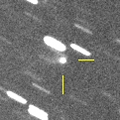
|
Now it is 14.8 mag (Dec. 23, Toshihiko Ikemura, Hirohisa Sato). It will fade out rapidly after this, and it will be fainter than 18 mag in March. It is observable in good condition in the Southern Hemisphere. It locates somewhat low in the Northern Hemisphere.
Date(TT) R.A. (2000) Decl. Delta r Elong. m1 Best Time(A, h)
Jan. 4 22 21.05 -3 41.8 2.223 1.813 53 15.4 18:31 ( 58, 33)
Jan. 11 22 36.91 -1 34.2 2.283 1.825 50 15.6 18:36 ( 63, 31)
|
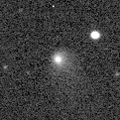
|
Now it is 14.8 mag (Dec. 28, Chris Wyatt). It will be fading slowly after this. In the Southern Hemisphere, it is observable for a long time. It stays low in the Northern Hemisphere.
Date(TT) R.A. (2000) Decl. Delta r Elong. m1 Best Time(A, h)
Jan. 4 23 5.84 -24 17.4 5.320 4.853 56 15.4 18:31 ( 34, 22)
Jan. 11 23 9.69 -22 59.0 5.441 4.887 51 15.5 18:36 ( 41, 20)
|
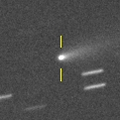
|
Now it is 15.6 mag (Dec. 27, Toshihiko Ikemura, Hirohisa Sato). It will fade out rapidly after this, and it will be fainter than 18 mag in March.
Date(TT) R.A. (2000) Decl. Delta r Elong. m1 Best Time(A, h)
Jan. 4 11 16.36 11 41.8 1.217 1.882 117 15.4 4:25 ( 0, 67)
Jan. 11 11 22.59 11 49.7 1.183 1.905 122 15.6 4:04 ( 0, 67)
|

|
Now it is 15.6 mag (Dec. 28, Toshihiko Ikemura, Hirohisa Sato). It will be fading gradually after this. It will be fainter than 18 mag in April.
Date(TT) R.A. (2000) Decl. Delta r Elong. m1 Best Time(A, h)
Jan. 4 9 35.23 5 21.8 2.091 2.896 137 15.5 2:45 ( 0, 60)
Jan. 11 9 31.42 5 30.5 2.064 2.928 145 15.6 2:13 ( 0, 60)
|

|
Now it is 16.0 mag (Jan. 1, Toshihiko Ikemura, Hirohisa Sato). It will brighten up to 13.5-14 mag from 2020 to 2021. It stays observable in good condition for a long time after this until 2020 summer.
Date(TT) R.A. (2000) Decl. Delta r Elong. m1 Best Time(A, h)
Jan. 4 13 2.81 11 36.4 3.358 3.546 92 15.7 5:38 (340, 65)
Jan. 11 13 7.18 11 41.3 3.243 3.528 98 15.6 5:38 (354, 66)
|
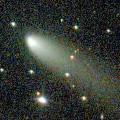
|
It brightened up to 11.4 mag in autumn (Nov. 10, Carlos Labordena). Now it is fading. It has already faded down to 14.8 mag (Dec. 28, Chris Wyatt). It is observable in excellent condition in the Northern Hemisphere. It stays locating extremely low in the Southern Hemisphere.
Date(TT) R.A. (2000) Decl. Delta r Elong. m1 Best Time(A, h)
Jan. 4 2 51.09 43 18.6 1.132 1.887 126 15.6 19:58 (180, 82)
Jan. 11 3 1.01 42 23.1 1.225 1.933 121 16.0 19:41 (180, 83)
|
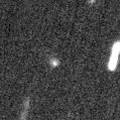
|
Now it is 15.6 mag (Jan. 4, Toshihiko Ikemura, Hirohisa Sato). It will brighten up to 10.5 mag from 2020 December to 2021 January. In the Northern Hemisphere, it stays observable in good condition while the comet will be brightening gradually, but it is not observable at the high light. In the Southern Hemisphere, it is not observable for a long time, but it will be observable in good condition after the high light.
Date(TT) R.A. (2000) Decl. Delta r Elong. m1 Best Time(A, h)
Jan. 4 17 51.90 60 20.2 4.216 4.231 84 15.9 5:38 (216, 34)
Jan. 11 17 59.68 60 26.9 4.149 4.167 84 15.8 5:38 (217, 37)
|
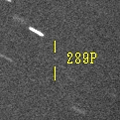
|
It brighted rapidly from 20.5 mag up to 18.5 mag in September. However, the brightness evolution has stopped since October. Now it is very faint as 18.0 mag (Dec. 29, Michael Jager). Michael Jager reported it has a faint coma with a diameter of 50-60 arcsec. It will approaches to Earth down to 0.09 a.u. in early January, and it will brighten up to 15.5 mag. It will be obesrvable in excellent condition in the Northern Hemisphere. In the Southern Hemisphere, it will not be observable at the high light.
Date(TT) R.A. (2000) Decl. Delta r Elong. m1 Best Time(A, h)
Jan. 4 23 39.00 28 16.5 0.104 0.980 85 16.7 18:31 ( 83, 68)
Jan. 11 0 45.14 53 43.8 0.091 1.006 101 15.9 18:36 (156, 67)
|

|
Now it is 15.3 mag (Jan. 5, Toshihiko Ikemura, Hirohisa Sato). It is expected to be observable at 5-6 mag for a long time from 2022 to 2023. In the Northern Hemisphere, it is not observable at the high light from 2022 summer to 2023 summer. In the Southern Hemisphere, it stays unobservable for a while. But it will be observable in good condition at the high light.
Date(TT) R.A. (2000) Decl. Delta r Elong. m1 Best Time(A, h)
Jan. 4 17 51.12 45 23.6 10.397 10.100 69 16.1 5:38 (233, 30)
Jan. 11 17 54.84 45 26.2 10.336 10.051 70 16.1 5:38 (235, 34)
|

|
It will be fading slowly after this. In the Southern Hemisphere, it stays observable in good condition for a long time. It will never be observable after this in the Northern Hemisphere.
Date(TT) R.A. (2000) Decl. Delta r Elong. m1 Best Time(A, h)
Jan. 4 14 32.79 -62 36.9 5.020 4.588 58 16.1 5:38 (346,-11)
Jan. 11 14 32.47 -64 16.6 4.991 4.631 63 16.1 5:38 (350,-11)
|
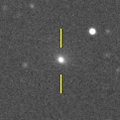
|
Now it is 15.4 mag (Dec. 23, Toshihiko Ikemura, Hirohisa Sato). It will be fading slowly after this.
Date(TT) R.A. (2000) Decl. Delta r Elong. m1 Best Time(A, h)
Jan. 4 0 31.39 -2 20.5 2.244 2.346 83 16.2 18:31 ( 21, 51)
Jan. 11 0 41.06 -1 5.0 2.323 2.345 79 16.3 18:36 ( 30, 50)
|
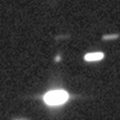
|
Now it is 17.0 mag (Jan. 3, Toshihiko Ikemura, Hirohisa Sato). It will brighten up to 13 mag in 2021. In 2020, it is observable at 15 mag in good condition from spring to summer.
Date(TT) R.A. (2000) Decl. Delta r Elong. m1 Best Time(A, h)
Jan. 4 14 50.37 -11 57.8 6.295 5.852 59 16.7 5:38 (318, 32)
Jan. 11 14 53.39 -12 33.2 6.149 5.808 65 16.6 5:38 (325, 35)
|

|
Now it is 17.5 mag (Dec. 28, Toshihiko Ikemura, Hirohisa Sato). It stays 16-17 mag for a long time until 2020. It is observable in good condition in the Northern Hemisphere. It is hardly observable in the Southern Hemisphere.
Date(TT) R.A. (2000) Decl. Delta r Elong. m1 Best Time(A, h)
Jan. 4 13 28.04 52 47.5 8.364 8.643 103 16.8 5:38 (206, 69)
Jan. 11 13 29.59 53 8.7 8.314 8.652 106 16.8 5:38 (195, 71)
|

|
Fading. Now it is 17.6 mag (Dec. 27, Toshihiko Ikemura, Hirohisa Sato). It stays 17 mag from autumn to winter. It is observable in good condition in the Northern Hemisphere. It locates low in the Southern Hemisphere.
Date(TT) R.A. (2000) Decl. Delta r Elong. m1 Best Time(A, h)
Jan. 4 8 43.23 23 53.0 5.889 6.795 155 17.0 1:53 ( 0, 79)
Jan. 11 8 36.82 23 55.3 5.889 6.839 163 17.0 1:19 ( 0, 79)
|

|
Now it is 18.2 mag (Jan. 1, Toshihiko Ikemura, Hirohisa Sato). It will brighten very rapidly after this. It will brighten up to 8-9 mag from summer to autumn. It will be observable in excellent condition in the Southern Hemisphere. It locates very low around the high light in the Northern Hemisphere.
Date(TT) R.A. (2000) Decl. Delta r Elong. m1 Best Time(A, h)
Jan. 4 13 11.30 -3 20.0 2.703 2.796 85 17.5 5:38 (343, 50)
Jan. 11 13 17.80 -3 53.5 2.564 2.754 90 17.2 5:38 (352, 51)
|
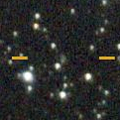
|
Now it is 16.6 mag (Dec. 27, Toshihiko Ikemura, Hirohisa Sato). It will brighten up to 12 mag in winter in 2022.
Date(TT) R.A. (2000) Decl. Delta r Elong. m1 Best Time(A, h)
Jan. 4 22 18.68 40 39.8 7.246 7.125 79 17.3 18:31 (113, 53)
Jan. 11 22 22.96 40 30.0 7.275 7.080 74 17.3 18:36 (114, 48)
|
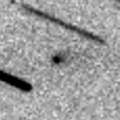
|
Now it is 17.5 mag (Jan. 5, Toshihiko Ikemura, Hirohisa Sato). It is brightening even after the perihelion passage. It will be fainter than 18 mag in January. However, it may stay bright for some more time. It is observable in good condition in the Northern Hemisphere. It locates low in the Southern Hemisphere.
Date(TT) R.A. (2000) Decl. Delta r Elong. m1 Best Time(A, h)
Jan. 4 10 42.34 48 1.4 0.952 1.745 128 17.5 3:51 (180, 77)
Jan. 11 10 48.43 51 16.2 0.962 1.773 131 17.7 3:30 (180, 74)
|
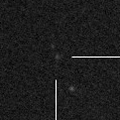
|
Now it is 17.9 mag (Dec. 5, R. L. Flynn). It is observable at 17-18 mag for a long time from late 2019 to early 2021. It will fade out before it passes the perihelion.
Date(TT) R.A. (2000) Decl. Delta r Elong. m1 Best Time(A, h)
Jan. 4 2 52.06 1 41.0 4.552 5.079 117 17.5 19:58 ( 0, 57)
Jan. 11 2 51.53 2 5.5 4.637 5.066 110 17.6 19:30 ( 0, 57)
|

|
Now it is 17.4 mag (Dec. 28, Toshihiko Ikemura, Hirohisa Sato). It stays observable at 16.5 mag for a long time from 2020 to 2021. In the Northern Hemipshere, it is observable in excellent condition for a long time. In the Southern Hemisphere, it is not observable until 2021 summer.
Date(TT) R.A. (2000) Decl. Delta r Elong. m1 Best Time(A, h)
Jan. 4 1 17.13 79 31.2 6.189 6.641 113 17.6 18:31 (180, 45)
Jan. 11 1 5.99 78 5.7 6.212 6.620 110 17.6 18:36 (176, 47)
|

|
Now it is 17.0 mag (Dec. 27, Toshihiko Ikemura, Hirohisa Sato). It stays bright even after the perihelion passage. It will fade out rapidly after this, and it will be fainter than 18 mag in January. However, it may stay bright for some more time.
Date(TT) R.A. (2000) Decl. Delta r Elong. m1 Best Time(A, h)
Jan. 4 3 10.38 -0 28.0 2.407 3.028 120 17.6 20:17 ( 0, 55)
Jan. 11 3 12.66 0 9.1 2.542 3.084 114 17.8 19:52 ( 0, 55)
|
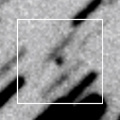
|
Asteroid moving along a comet-like orbit. Now it is 16.5 mag (Dec. 27, Toshihiko Ikemura, Hirohisa Sato). It stays observable at 17 mag from 2020 to 2021. It locates somewhat low in the Northern Hemisphere.
Date(TT) R.A. (2000) Decl. Delta r Elong. m1 Best Time(A, h)
Jan. 4 10 59.84 -24 47.0 6.325 6.632 104 17.7 4:09 ( 0, 30)
Jan. 11 11 0.04 -25 2.7 6.225 6.627 110 17.6 3:41 ( 0, 30)
|

|
Now it is 17.8 mag (Dec. 28, Toshihiko Ikemura, Hirohisa Sato). It will brighten up to 16 mag in March, and it will be observable in good condition.
Date(TT) R.A. (2000) Decl. Delta r Elong. m1 Best Time(A, h)
Jan. 4 11 55.10 44 0.1 1.307 1.953 116 17.8 5:04 (180, 81)
Jan. 11 11 59.35 44 3.8 1.225 1.921 120 17.7 4:41 (180, 81)
|

|
Now it is 17.7 mag (Dec. 31, Toshihiko Ikemura, Hirohisa Sato). It will be fainter than 18 mag in 2020 spring.
Date(TT) R.A. (2000) Decl. Delta r Elong. m1 Best Time(A, h)
Jan. 4 12 43.62 7 5.2 10.494 10.633 95 17.8 5:38 (352, 62)
Jan. 11 12 44.49 7 15.4 10.396 10.650 102 17.8 5:26 ( 0, 62)
|

|
It brightened up to 14 mag from autumn to winter in 2018. Now it is fading. It is observable at 17.5 mag in good condition from winter to spring.
Date(TT) R.A. (2000) Decl. Delta r Elong. m1 Best Time(A, h)
Jan. 4 13 45.27 -1 25.7 4.266 4.175 78 17.8 5:38 (330, 49)
Jan. 11 13 47.24 -1 52.0 4.196 4.216 84 17.8 5:38 (340, 51)
|
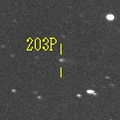
|
Now it is 16.5 mag (Dec. 28, Toshihiko Ikemura, Hirohisa Sato). It is observable at 17 mag in good condition in winter. It locates somewhat low in the Southern Hemisphere.
Date(TT) R.A. (2000) Decl. Delta r Elong. m1 Best Time(A, h)
Jan. 4 3 55.99 22 50.0 2.411 3.216 138 17.8 21:02 ( 0, 78)
Jan. 11 3 54.87 22 38.1 2.477 3.213 131 17.9 20:34 ( 0, 78)
|
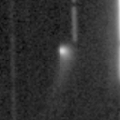
|
Now it is 17.8 mag (Dec. 27, Toshihiko Ikemura, Hirohisa Sato). It will be fading after this. In the Northern Hemisphere, it stays observable in good condition for a long time. In the Southern Hemisphere, it stays extremely low for a long time.
Date(TT) R.A. (2000) Decl. Delta r Elong. m1 Best Time(A, h)
Jan. 4 0 57.15 26 48.5 4.340 4.620 100 17.8 18:31 ( 37, 80)
Jan. 11 0 56.18 25 32.6 4.507 4.663 92 18.0 18:36 ( 58, 74)
|

|
Fading now. Now it is 16.3 mag (Dec. 26, Martin Masek). In the Southern Hemisphere, it stays observable for a long time until it fades out. In the Northern Hemisphere, it will not be observable after this.
Date(TT) R.A. (2000) Decl. Delta r Elong. m1 Best Time(A, h)
Jan. 4 4 50.75 -55 43.1 5.553 5.758 97 17.9 21:55 ( 0, -1)
Jan. 11 4 41.30 -55 20.0 5.639 5.810 95 18.0 21:19 ( 0, 0)
|

|
It will brighten up to 13 mag in 2022. In 2020, it is observable at 17.5 mag in good condition in spring. It locates somewhat low in the Southern Hemisphere.
Date(TT) R.A. (2000) Decl. Delta r Elong. m1 Best Time(A, h)
Jan. 4 10 55.54 17 45.4 4.014 4.635 123 18.0 4:05 ( 0, 73)
Jan. 11 10 54.60 18 6.0 3.917 4.623 131 17.9 3:36 ( 0, 73)
|
|
![]()
 C/2019 K1 ( ATLAS )
C/2019 K1 ( ATLAS ) 68P/Klemola
68P/Klemola C/2018 A6 ( Gibbs )
C/2018 A6 ( Gibbs ) 2I/2019 Q4 ( Borisov )
2I/2019 Q4 ( Borisov ) C/2016 M1 ( PanSTARRS )
C/2016 M1 ( PanSTARRS ) 160P/LINEAR
160P/LINEAR C/2017 B3 ( LINEAR )
C/2017 B3 ( LINEAR ) 155P/Shoemaker 3
155P/Shoemaker 3 78P/Gehrels 2
78P/Gehrels 2 246P/NEAT
246P/NEAT 260P/McNaught
260P/McNaught C/2019 N1 ( ATLAS )
C/2019 N1 ( ATLAS ) 289P/Blanpain
289P/Blanpain C/2017 K2 ( PanSTARRS )
C/2017 K2 ( PanSTARRS ) C/2017 M4 ( ATLAS )
C/2017 M4 ( ATLAS ) 101P/Chernykh
101P/Chernykh C/2019 F1 ( ATLAS-Africano )
C/2019 F1 ( ATLAS-Africano ) C/2010 U3 ( Boattini )
C/2010 U3 ( Boattini ) C/2015 O1 ( PanSTARRS )
C/2015 O1 ( PanSTARRS ) 88P/Howell
88P/Howell C/2019 L3 ( ATLAS )
C/2019 L3 ( ATLAS ) 76P/West-Kohoutek-Ikemura
76P/West-Kohoutek-Ikemura 173P/Mueller 5
173P/Mueller 5 C/2019 T3 ( ATLAS )
C/2019 T3 ( ATLAS ) C/2019 K5 ( Young )
C/2019 K5 ( Young ) A/2019 C1
A/2019 C1 124P/Mrkos
124P/Mrkos C/2014 B1 ( Schwartz )
C/2014 B1 ( Schwartz ) (944) Hidalgo
(944) Hidalgo 203P/Korlevic
203P/Korlevic C/2018 A3 ( ATLAS )
C/2018 A3 ( ATLAS ) C/2016 N6 ( PanSTARRS )
C/2016 N6 ( PanSTARRS ) 117P/Helin-Roman-Alu 1
117P/Helin-Roman-Alu 1![]()


































